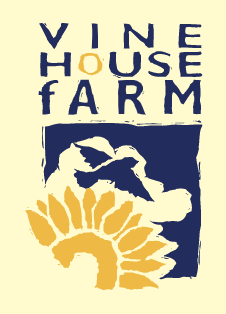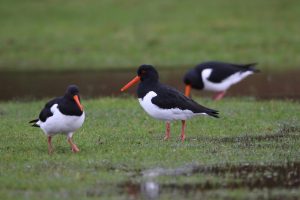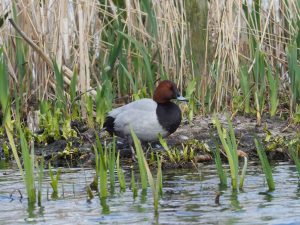
What a Fabulous February and a Miserable March we have had! If you remember, February was drier than average, no strong winds and above average sunshine. March has been the opposite, above average winds, less sunshine than normal and above average rainfall. There have been only three wetter Marches in the last 50 years here. March is the only month that I have never recorded 4ins of rain, the maximum being 91mm. We have had 80mm this month, has anyone had less? The temperature has been slightly warmer than normal.

We finished drilling our spring barley and spring oats during the first few days of the month; they’re all in rows looking very nice. It was good to get these crops in earlier than normal, they’ll get their roots down in case it becomes dry. A perfect start to Spring, but the wet weather has put things on hold since then. The only day since March 5th we were able to do anything in the fields was on March 27th, when we applied nitrogen to our wheat crops.
The blank rows in a field of corn are called tramlines, and are there to guide the tractor drivers with the sprayer and the fertiliser spreader; our tramlines are every 36 metres. Our drill is six metres wide, so every six metres we stop two coulters from sowing and we also have a sprayer that covers 36 metres. The fertiliser spreader is a bit more complicated, obviously it needs to spread 36 metres wide but the two spinning discs that throw the fertiliser have to be going at the right speed, and set at the right angle. One disc can be set differently to the other, so when the spreader is going round the outside of the field, fertiliser is not thrown into the hedge or watercourse. It’s surprising how accurate the discs are, if set correctly.
The fertiliser has to be capable of being spread to 36 metres. This wide, the discs are spinning very fast and the prills – the little globules of fertiliser, have to be hard enough not to disintegrate when they get hit by the spinning discs. It’s best to buy the British made material rather than a cheaper imported material, which may well turn to dust when it falls on the discs.
Once that’s all set up, we also have to know how fast the tractor should travel. Our spreader can travel at 18 km/h which means we can get a lot of fertiliser applied, about 50 acres an hour. Such a transformation from 60 years ago when it would have been only an acre an hour. We have smaller fields than our neighbours, so we would be turning more often than they would, meaning that they would be getting even more acres per hour spread than we would. We have smaller fields because we haven’t filled in all the redundant dykes and we’ve made those redundant dykes a feature with wide margins against them, so they are good habitats for wildlife.
There are thousands of people out there trying to improve the machines we are operating such as I have described. In the last 60 years, we have gone from having to employ a man for every 100 acres we are farming, to a man for every 1000 or even 2000 acres we are farming. It is of course happening in every industry and it is a wonder that everyone who wants a job can have a job.


Spring is coming of course and as I am writing this, I just had to open the office window to hear all the Blackbirds and Robins singing in the half light. It was a fabulous dawn chorus.
I’m sure we have more birds around our yard than most farmers, as we move seed about most days of the week. Some of those seeds are as attractive to birds as chocolate is to us and small amounts sometimes get spilt.
I heard and saw my first Spring migrant on a nature reserve on March 19th, it was a Chiffchaff. More are coming in now and I heard one in the garden ten days later. The Chiffchaff’s song is very distinctive, it goes ‘chiff-chaff-chiff-chaff‘, but not likely to be heard very often in the centre of towns.
As usual, Blackbirds were eating a lot of seed during the first half of March and then half of them disappeared. I used to think the females were sitting on eggs, but it was because half, or even more, of them were on their way back to Scandinavia. Maybe one or two of them that breed in our garden come back from their holiday homes in Cornwall or Devon, we know this happens because ringed birds have been caught in both places.
I have a charm of Goldfinches that are singing and flying around some cherry trees, looking for nest sites. It’s lovely to hear and see them, just another sign of Spring.
We have a Robin which has built a nest in the farm workshop, no eggs yet but I will be keeping an eye on it and I will make sure that it has access to live mealworms. I get more enjoyment out of feeding live mealworms than feeding any other bird food.
I feed live mealworms in a cage, so that Starlings and Blackbirds are unable to get in. The feeder is on the ground, which allows more species to get to them. Starlings and Blackbirds wait outside the feeder; the Starlings try to pinch a mealworm from the birds on their way out, whereas the Blackbirds – being more polite than the Starlings – wait for a mealworm to be dropped.
I don’t ignore the Blackbirds and Starlings though, I feed them on soaked sultanas in another cage which the Wood Pigeons and Jackdaws can’t access.
It’s an enjoyable time watching it all going on and such a benefit to wildlife. RSPB studies have shown that if we feed live mealworms in our gardens during April, May and June, we will rear 50% more birds in our garden and if we want to see a lot of birds, we need to rear a lot of birds.
Every bird has to take its nestlings moist food, as it can’t take them water, so the water has to be included in the food and that moist food is live insects.



